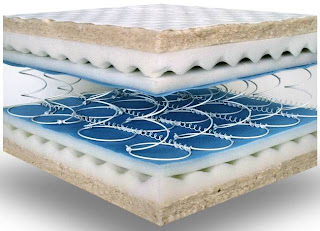Other than your Pillow, there is probably nothing more important to getting a good night's sleep than your mattress. But with so many choices available: traditional coil, air, latex, and memory foam mattresses among the top options, buying a new one can be very confusing. Lots of fancy features and a high price tag doesn't necessarily point to a superior product. The real measure of a mattresses quality and value to is whether it is firm enough to provide support to the user's back, neck and legs and still offer cushion and recoil for comfort.
It's a delicate balance between two objectives - You want enough firmness in a mattress to distribute your weight or else you will sleep uncomfortably and wake up sore from sagging shoulders and hips. At the same time you don't want to sleep on a board. Between the extremes of soft and firm, most experts agree the best mattress choice should be on the firm side for best overall comfort and support. But because there is wide variation between people in terms size, weight and sleeping patterns, that it is difficult to identify a "best" for everyone.
Mattress Shopping Tips
Physical therapists recommend mattresses that let you relax but also support the natural S curve of the back. Try several mattresses and spend 15 - 20 minutes per mattress trying out your favorite sleeping positions: on your back, side and stomach. And if you have a significant other, she or he should participate in the test.
When you lie on your side if you feel your shoulders or hips sinking, then your spine is not aligned and the mattress is too soft. If you feel any pain or pressure points, then the mattress is probably too firm.
It's a good idea to shop late in the day, when possible. When you are fresh and rested in the morning, you might not notice some discomfort that could really bother you later in the day when you're tired. Also, look for a mattress store that offers a 30-day refund policy, so that you have an opportunity to really evaluate the mattress under actual use.
The "best" mattress doesn't have to be the most expensive one. But whatever you pick should be well constructed.
Coil vs. Foam Mattresses
Many people favor traditional coil mattresses for maximum comfort and support. Coil density is an important factor: the more coils per mattress, the smaller the coils, and the more flexible the mattress. 680 coils or more per mattress provides good support and flexibility. Heavier people will need larger, and therefore fewer coils per mattress, typically around 400.
Some people find that memory foam or latex mattresses are more comfortable, they are not necessarily better for your health or long term comfort. These mattresses react to body heat and pressure and mold to the body's shape within minutes.
These types of mattresses are great if you tend to sleep in the same position. They are also useful for people with sensitive joints or arthritis who don't want pressure on the joints. But if you move around during sleep (which is good for the skin and body), there is no need for material that remembers your position, since it's changing frequently. Instead you want a mattress that accommodates all of your sleeping positions.
Other Mattress Options
Air mattresses use inflatable air chambers for support. Dual chamber types allow two people to adjust the firmness of their side of the bed to satisfy their own tastes. Lots of small chambers make for a more flexible and comfortable sleeping surface than a few large chambers.
Another popular option is pillow-top mattresses which add a layer of soft cushioning to a mattress. Their soft tops allow for the choice of a firmer bottom mattress.
The bottom line for any mattress is comfort and whether it provides a good night's sleep without causing any pain or stiffness in your body.
Back problems and Allergy Woes
Sleepers with back problems should always seek firmer mattresses that allow them to sleep straighter with good spine alignment. Adjustable beds that allow the upper or lower part of the body to be elevated are often not useful as most people sleep best when they lie flat.
But hospital type beds can be helpful for people with certain spinal conditions, such as spinal stenosis. People with this condition feel most comfortable when their body is bent slightly forward. On the other hand people with sciatica due to a herniated disk sleep more comfortably on a flat bed.
Sleepers with allergies to molds, dust mites and other substances may benefit from hypoallergenic mattress cover. Most people , however, don't have this problem.
The Right Bed Frame
Because of different mattress and box spring thicknesses, the height of a bed may make it difficult for the elderly or people with balance problems to get in and out of bed. In such cases, a sunken frame may be helpful. The goal is to keep the distance between the floor and the sleeping surface to around 18 inches.
Mattress Life
Following manufacturers recommendations to rotate and flip a mattress every six months should result in a mattress life of around 10 years (foam and pillow-top mattresses only need rotating).
Sagging mattresses can helped by inserting a piece of plywood between the mattress and box spring. Also check to see that your bed slats are not sagging as is often the case over time. Finally, if you can feel the springs through the top of your mattress, you can extend its life by covering it with soft foam egg crate mattress pads.





